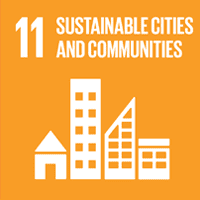11
KOTA DAN PEMUKIMAN YANG BERKELANJUTAN
Menjadikan Kota dan Permukiman Inklusif, Aman, Tangguh dan Berkelanjutan
Sustainable Cities and Communities

Universitas Nahdlatul Ulama Surabaya (Unusa) is deeply committed to preserving and promoting cultural heritage, aligning its efforts with Sustainable Development Goal 11 (Sustainable Cities and Communities). The university recognizes the importance of cultural heritage in fostering a sense of identity, community, and continuity. As part of this commitment, UII integrates heritage conservation and arts engagement into campus life, providing students, faculty, and the wider community with opportunities to engage with and preserve their cultural legacy. Through these initiatives, Unusa not only enriches the educational experience but also contributes to the cultural vitality of the surrounding community.
In addition to its cultural preservation efforts, Unusa has embraced sustainable practices across multiple areas of its operations. The university is committed to environmental responsibility and actively promotes sustainability in all aspects of its activities. This includes sustainable building practices, waste management initiatives, and energy-efficient solutions, ensuring that Unusa campus is a model for responsible environmental stewardship. By implementing these sustainable practices, Unusa sets an example for its students and the broader community, demonstrating the importance of balancing development with environmental care.
Unusa commitment to sustainability also extends beyond the physical campus to include community support and sustainable urban development. The university works closely with local communities, providing resources, education, and support for sustainable practices that benefit both the environment and local livelihoods. Through partnerships with local governments, businesses, and NGOs, Unusa is helping to create sustainable urban spaces that are resilient, inclusive, and culturally rich. This approach reflects the university’s broader commitment to contributing to the achievement of SDG 11 by promoting sustainable and thriving cities and communities.
By integrating cultural heritage conservation with sustainable practices, Unusa is working toward a more holistic approach to urban development, where sustainability and cultural preservation go hand in hand. This commitment not only enhances the university’s campus life but also contributes to building stronger, more sustainable communities that are better equipped to face the challenges of the future.
Unusa Support for Arts and Heritage
- Public Access to Heritage Sites
- Library Access
- Promotion of Local Arts
- Preservation of Intangible Cultural Heritage
Unusa has preserved the 10th-century Kimpulan Temple found on its campus and incorporated it into its library complex. This integration not only allows students and visitors to engage with local heritage but also contributes to sustainable cultural tourism and educational outreach, underscoring Unusa dedication to heritage conservation.
Unusa libraries are open to students, lecturers, and staff, offering free access to a range of resources. External visitors can also access library services for a nominal fee. The library additionally provides open access to UII’s published journals and digital publications through Unusa Press, enhancing community knowledge-sharing and accessibility.
Unusa hosts numerous cultural performances each year, including student-led choirs, theater groups, orchestras, and traditional dances like the Acehnese Saman. These events support a vibrant campus culture, enriching student life and contributing to the cultural vitality of the wider community.
Unusa library actively contribute to cultural preservation through projects that document local architectural styles and safeguard historical texts. This helps maintain the cultural identity of the area and encourages sustainable tourism.
Unusa Sustainable Practices
- Sustainable Commuting Targets
- Sustainable Commuting Promotion
- Telecommuting and Remote Working
- Affordable Employee Housing
- Affordable Student Housing
- Prioritization of Pedestrian Access
- Collaboration on Local Development
- Sustainable Building Standards
- Use of Brownfield Sites
Unusa is actively involved in research on electric vehicles, notably through the development of electric motorcycle prototypes. This initiative demonstrates Unusa commitment to reducing carbon emissions and promoting sustainable transportation options on campus.
Unusa provides free campus buses, bicycle parking, storage facilities, and dedicated cycle paths. A campus-wide pedestrian plan and managed parking zones further support sustainable commuting, making it easier for students and staff to use non-motorized or shared transportation.
Unusa has implemented work-from-home and remote working policies, especially during the COVID-19 pandemic. This practice not only supports employee well-being but also reduces carbon emissions from commuting, contributing to sustainable urban development.
Unusa addresses housing needs through the Graha Unisia Permai Estate project, offering affordable housing options to employees. This initiative helps build sustainable communities and aligns with UII’s commitment to staff welfare.
Unusa provides monthly housing subsidies of IDR 1 million for academically deserving international students, alleviating financial burdens and supporting a diverse student body. This program contributes to intercultural exchange and community building.
Unusa campus master plan emphasizes pedestrian safety with buildings located within walking distance, connected by covered walkways. This design creates a safe, accessible campus environment and prioritizes pedestrian-friendly infrastructure.
The Center for Real Estate Study at UII’s Department of Architecture conducts research on sustainable and affordable housing solutions, collaborating with local authorities to address planning issues and support affordable housing access for the wider community.
Most campus buildings are designed in-house by UII’s Department of Architecture, following local green building standards. Though yet to be formally certified, Unusa buildings incorporate Green Building principles, reflecting a commitment to environmental sustainability.
Unusa has taken proactive steps to minimize environmental impact by primarily building on previously developed or unproductive land. This approach, combined with the university’s commitment to maintaining 70% green spaces, promotes biodiversity and air quality improvements.
